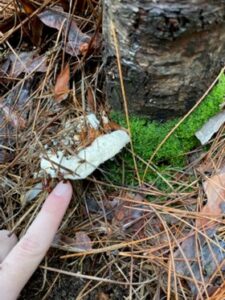By Alex Feltmeyer, Forest Health Specialist, Plover, Alexandra.Feltmeyer@wisconsin.gov or 715-340-3810

A Heterobasidion root disease fruiting body is found at the base of a white pine sapling in the understory. Photo: Wisconsin DNR Forest Health
Heterobasidion Root Disease (formerly annosum root rot or Fomes root rot) is a serious disease of conifers that causes reduced height, shoot and diameter growth along with thin and yellowish/red foliage, ultimately causing mortality.
The disease becomes established in a new stand when spores of the fungus land on freshly cut stumps made by any forest management that creates cut stumps. After the disease becomes established, it spreads underground through root systems into adjacent trees. In this way, we often find pockets or groups of trees in various stages of decline.
Movement through the root systems contributes to significant spread throughout stands of conifers, impacting the regeneration of conifers within these pockets.
Mortality usually starts occurring three to eight years after a thinning operation. During this time, perennial fruiting bodies of the fungus begin to develop around the base of cut stumps or dead trees.
